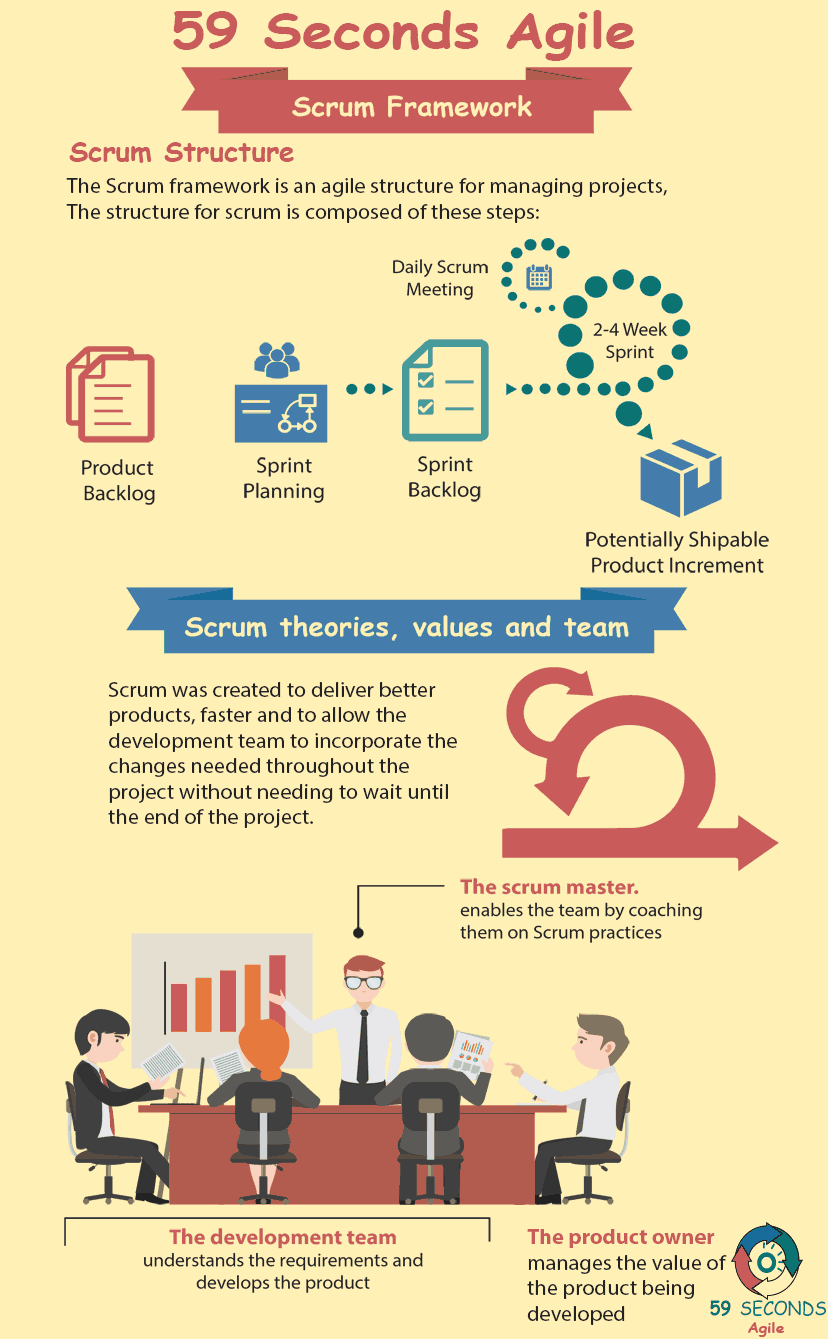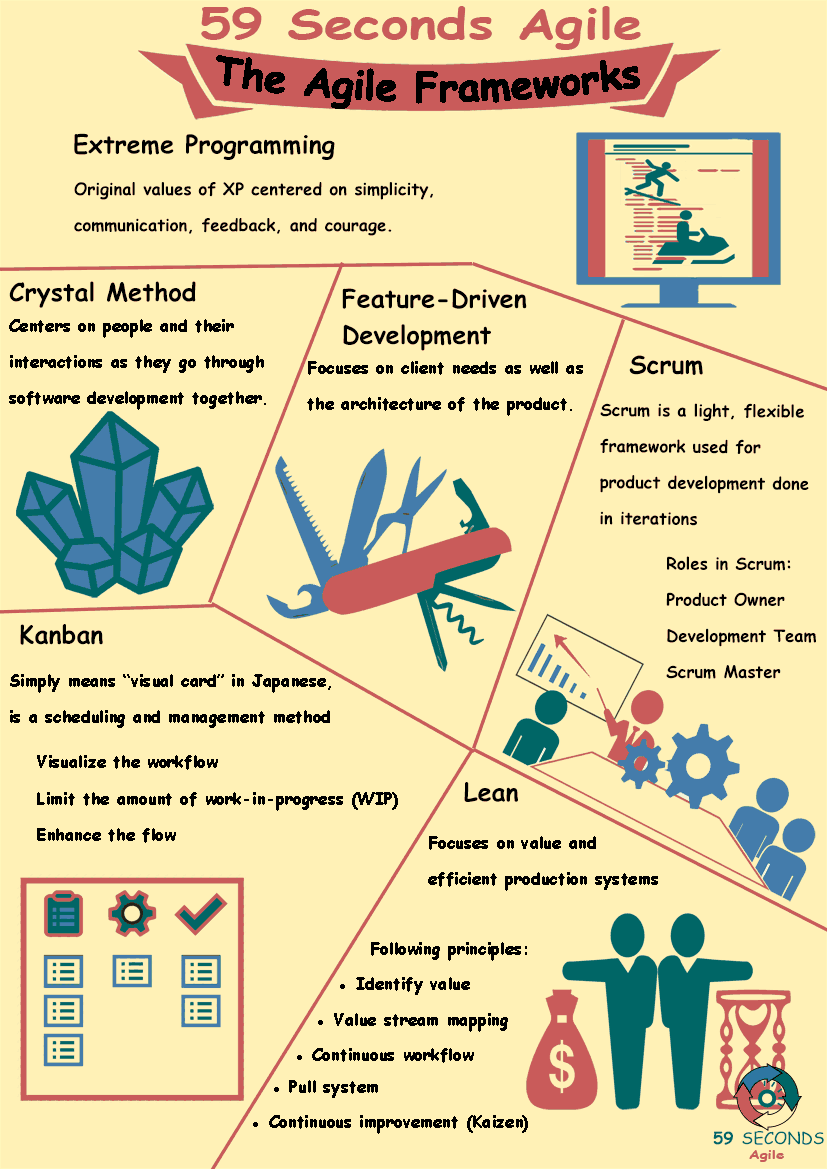What is the Scrum Framework and how do the development team go about Implementing Scrum? Lets take a look at What is the Scrum Framework and consider the Scrum Theory, values and principles.
The Agile Frameworks
A 59 Seconds Agile Video Animation
The Scrum Framework and Implementing Scrum
A 59 Seconds Agile Article
Agile Software development is any development environment that follows the twelve principles of the Agile Manifesto. Different ways of applying these principles are called frameworks. Some of the more popular Agile frameworks are Scrum, Kanban, and Extreme Programming. The Scrum framework follows several theories and values and sticks to a specific team build.
By anticipating the different parts of the Scrum framework, and its differences from traditional programming, developers can work more efficiently. When developers know what to expect of themselves, and of the Scrum Team (Scrum Master, Product Owner and Development Team), they can focus on creating working software.
What is The Scrum Framework?
Scrum is a framework of Agile software development that can work equally well for both large and complex projects and small and simple projects. Because of its adaptive nature, Scrum is attractive to many different organizations. Whether the organization needs to build small projects, large projects, or a mix of both, Scrum works for any size and complexity. Scrum teams can work for months or even years on large software products. Many Agile frameworks might slow their pace over time because of technical debt or other hurdles. Scrum allows time and meetings to planning and problem-solving. By working through several sprints, a Scrum team develops a velocity. The velocity is the average number of story points that the team delivers each sprint.
The Scrum Framework for Developers
For developers in a Scrum framework, the differences between Scrum teams and traditional development teams create very different environments. For one, the self-organizing teams of Scrum mean that developers can gravitate toward work that they better understand. Instead of working on only what they receive instruction for, Scrum developers can pick up assignments that they know more about. Scrum teams are also multi-disciplined, and developers work hand in hand with other roles. Traditional development environments usually have developers only work with other developers. On a Scrum team, all roles involved in the development process are present.

The Scrum Framework and the Scrum Theory
There are a few theories that the Scrum framework sticks to. These theories include iterative sprints, transparency, inspection, and adaptation. By applying these theories to the development process, Scrum development can operate more efficiently than traditional waterfall development.
Iterative sprints refer to the process of improving the development environment over time. In Scrum development, a project is divided into many sprints. These sprints are between 2 and 6 weeks long. At the end of each sprint, the Scrum team examines the previous sprint and plans for the following sprint. By breaking up the project into smaller time frames, the team can gradually improve methods and processes.
Using iterative sprints also benefits stakeholders. The goal of Scrum is to produce working pieces of software within each sprint. At the end of the sprint, the Scrum team should have individual components of the product that can work on their own. These components are then delivered to the stakeholders. Since stakeholders can use these working pieces, they can offer feedback on what they do and don’t like the pieces of the product that are already finished. Developers can then use this feedback to improve their work on future components and features through the use of user stories.
Transparency means that all stakeholders can see and understand the process of development. Instead of hiding practices and methods within separate departments, all parties can see and understand all areas from start to finish. By using language and terms that all stakeholders understand, different roles can communicate more effectively. Developers can understand the work and processes of other roles, even without an extensive knowledge of each role.
Prev <— Continue Reading —> Next
User Stories Applied
A 59 Seconds Agile Book Review
User Stories Applied by Mike Cohn is one of our favourite books on Agile User Stories. The book starts with an overview into user stories, and details what a user story is and the different aspects of them. He then discusses how to go about writing a user story, and provides details of the INVEST criteria that can be used to determine if the story is meeting all of its objectives. Next Mike gives an in depth discussion of who user stories are written for and where to begin when gathering the details for them. The book then discusses acceptance testing user stories, including how to go about specifying these criteria and the responsibilities of the development team and customers during this process.
Prev <— Continue Reading —> Next
The Agile Frameworks
A 59 Seconds Agile Infographic

Prev <— Continue Reading —> Next
Our Favourite Agile Books
We found these books great for finding out more information on Agile Scrum:

